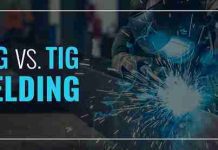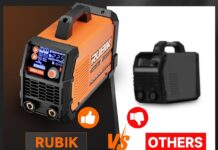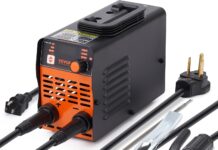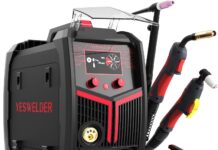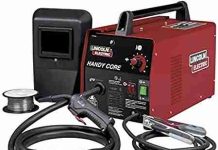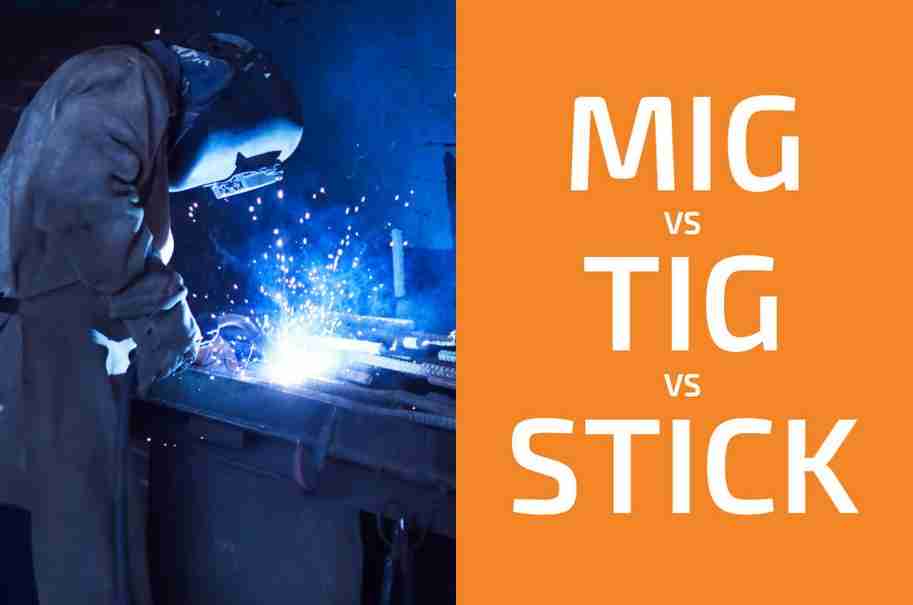As you know, welding is the way to join stainless steel parts for repair or craft projects. But what type of welding is best for stainless steel?
Before continuing with the article, it is recommended that you look at our article Types of Welding: TIG vs. MIG vs. Electrode vs. Arc, where we explain the different welding methods and their advantages and disadvantages.
This article explains the different ways of welding stainless steel and the most appropriate methods.
Each must choose the most appropriate process according to the application given from these options. Let’s go there!
Forney Easy Weld 140 MP, Multi-Process Welder
Before you start
In this complete guide, we will go step by step. Before you start welding, you should know some things, and choosing the best welding method to meet your needs is necessary.
Identify the type of stainless steel you want to weld.
Stainless steel is composed of iron (Fe), Carbon (C), and Chrome (Cr). The fundamental element is iron, but chromium makes steel stainless. Or this, the minimum proportion of chromium must be 11.5%.
Stainless steels are divided into three main groups (others are not used as much), and each type is identified by the three digits that are usually printed on the steel:
- Martensitic stainless steel: Steel has a chromium ratio between 11.5% and 18%. t is magnetic and produces long white sparks with few forks. t is used for wear-resistant projects. Some examples are AISI 410, 416, 420, 431, 501, and 502 steel sheets.
- Ferritic steel contains between 17-18% and 27% chromium. t is widespread, and its high carbon content makes it magnetic. Hen milled produces white or red sparks with a few forks. Erratic steel is AISI 405, 409, 432, 439, 442, and 446.
- Austenitic steel: The total nickel and chromium content is 23%. t is a relatively common type of steel that usually starts with the digit 3. They are non-magnetic in the annealing condition and do not harden by heat treatment.
Choose the suitable filler metal for your type of steel.
Depending on the type of stainless steel you must weld, choose a filler metal accordingly. f the metals you join are different, you must pick them based on less cracking chance and the most compatible with the base metal.
In the following tables, we help you choose the filling material for your stainless steel:
Contribution metal for martensitic stainless steels
| AISI steel | Recommended input metal | Alternative input metal |
| 403 | 410 | 308, 347, 309 |
| 410, 410S | 410 | 308, 347, 309 |
| 414 | 410 | 410 NM, 309 |
| 420 | 420 | 309 |
| 431 | 410 | 309, 310 |
| 440A | 312 | 309 |
Contribution metal for ferritic stainless steels
| AISI steel | Recommended input metal | Alternative input metal |
| 405 | 410 | 308L, 309, 410NM |
| 409 | 409CB | 430, 309LSi |
| 430 | 430 | 308L, 309L |
| 442 | 308L | 309L |
| 446 | 308L | 309L |
Contribution metal for austenitic stainless steels
| AISI steel | Recommended input metal | Alternative input metal |
| 201, 202, 205 | 240 | 308, 347, 309 |
| 301, 302, 302B | 308 | 347, 309 |
| 304, 304L | 308L | 347, 309 |
| 304H | 308H | 347, 309 |
| 303, 303SE | 312 | 309MO |
| 316, 309S | 309 | 309CB, 310 |
| 310, 310S, 314 | 310 | 310CB, 310MO |
| 316, 316L | 316, 316L | 309MO, 317 |
| 316H | 316H | 309MO, 317 |
| 317 | 317 | 317L, 309MO, 318 |
| 321 | 347 | 309CB, 310CB, 321 |
| 347, 348, 347H | 347 | 309CB, 310CB |
| 320 | 320LR | 320 |
| 330 | 330 | – |
| 904L | 385 | – |
If you are unsure of the type of stainless steel, the 309 works well in most situations.
Choose the type of joint you need to weld.
Achy joints can be welded in different ways, depending on the thickness and shape of the joint. You must make one point depending on how you need to join the pieces together. The most common junctions are the T-joint, the overlap joint, the edge joint, the corner joint, and the top joint.
Secure the parts you are going to weld.
Place the pieces you will weld on a work surface to work with stainless steel. Ut the two parts you want to join using different accessories that usually bring the welding tables.
If you have a standard table, you can secure them with parents or cheaters as firmly as possible so they do not move while welding.
Read Next – Laser Welding Stainless Steel
Clean the base stainless steel.
He makes welding better. Use a specific wire brush for stainless steel to clean the metal. Rub the brush to remove all impurities, and review with a wet rag of acetone to finish cleaning all debris.
If necessary, sandpaper and grinders can clean the steel and remove all impurities.
Type of welding for stainless steel
The most suitable processes for welding stainless steel are MIG and TIG. Although arc welding can also be used to weld stainless steel, it is not the most appropriate method, so we recommend you opt for TIG or MIG welding.
Gas for welding stainless steel with MIG or TIG
The gas we need for our project depends,s on the type of welding we will use (MIG or TIG) and, depending on that, the type of stainless steel we have or the filler material we use.
In the following table, we show you with which gas the stainless steel is welded in each case:
| MIG | TIG | ||
| Filling material/steel type | Basic and rutile tubular thread | Solid thread and metallic filler | – |
| Martensitic | 68% Argon, 20% Helium, 12% Dioxide c. | 63% Argon, 35% Helium, 2% Dioxide c. | 70% Argon, 30% Helium |
| Ferritic | 68% Argon, 20% Helium, 12% Dioxide c. | 63% Argon, 35% Helium, 2% Dioxide c. | 70% Argon, 30% Helium |
| Austenitic | 68% Argon, 20% Helium, 12% Dioxide c. | 63% Argon, 35% Helium, 2% Dioxide c. | 98% Argon, 2% Helium |
Although these are the ideal gases, other mixtures can also be used. A gas with 90% Helium, 7.5% Argon, and 2.5% Carbon Dioxide can be used for MIG welding of stainless steel and 98% Argon and 2% Carbon Dioxide for TIG stainless steel welding.
One last step before starting welding: Protection
Sparks can always jump during welding, so using as much protection as possible is essential. Using gloves and darkening helmets is vital and should be the minimum protection for welding work.
Welding aprons, respirator masks, and safety shoes are allowed. Ut, if you don’t have them, you should at least wear a long-sleeved shirt and long pants to avoid exposing the skin to any dangerous situation.
Read Next – MIG Vs. TIG Welding
TIG welding for stainless steel or How to weld stainless steel with TIG
TIG welding will weld stainless steel slightly thickly, approximately 6 mm. From then on, TIG welding will not be economical.
In TIG welding ( Tungsten Inert Gas), also known as GTAW (Gas Tungsten Arc Welding), the electric arc is established between the base metal and a non-consumable Tungsten electrode. Ll, this is done in a protective atmosphere created by the inert gas chosen for the project. His gas is used to protect the metal we melt for air welding.
The trouble is that TIG welding equipment is a little more complicated than MIG welders, and the welding process is also slower. n the contrary, it can create more robust and durable joints when done correctly than MIG welds.
First steps
Insert the sharp tungsten rod into the torch and start the gas. Hen, open the electrode by turning the torch and putting the tungsten rod of the appropriate diameter in the center of the cylinder. Adjust the rod, letting it protrude a little.
Turn on and configure the soldering iron.
Please turn on the soldering iron, setting it to DC (Continuous Current) mode. t will help if you put it in this configuration to weld the stainless steel properly.
In other inverter welders, which can use different functions and types of welding, it is sufficient to put it in TIG mode or TIG LIFT.
Read Next – What Is MIG Welding?
Get ready to start welding.
Light the TIG torch next to the joint you wish to weld. Hold the torch about 2 or 3 centimeters from the pieces’ junction and at an angle of 75 degrees. Old the torch at this distance and in this position while welding.
TIG welding process in stainless steel
They usually have a pedal to activate the torch, which lights it when pressed. You have to keep the torch still in one place until you see the metal melt, and when this happens, you have to move it to weld the entire joint.
You must ensure the metal does not splash; if it does, you should raise the welder’s amperage. t is a sign that the torch does not have enough strength. n the contrary, if you have too much energy or power, you will melt too much metal.
Fill the gasket while moving the rod.
Hold the rod with one hand and the torch with the other as the filler rod in the molten metal to fill the joint and create the cord along the entire joint.
Let it cool
Before moving the new part, you weld it and let it dry. The union has to solidify completely before moving it. The torch must also be cooled before storing it since if it is still hot; it can cause a fire.
PrimeWeld Pilot Arc 50A Plasma Cutter, 200A TIG/Stick Welder Combo, Multipurpose Welding Machine for Home or Jobsite Use with 1/2-inch Clean Cut, Plasma Cutter, TIG Welder and Stick Welder, CT520DP
Video
If you want to see on the video how the welding of stainless steel with TIG is done correctly, we leave you a video so you can do it:
MIG welding for stainless steel or How to weld stainless steel with MIG
MIGweldsknown as gas metal arc welding (GMAW), welds thick pieces. His welding is faster than TIG welding and easier to do, so you don’t have to be an experienced welder to get a good weld. The bad thing is that the created union is not so durable. t is more fragile. o for those who ask if you can weld stainless steel with MIG, the answer is YES.
The MIG torch has the filling material to be welded with one hand. His MIG welding process and the MAG (Metal Active Gas) process protect the welding with inert gas since an electric arc is established between a consumable electrode and the stainless steel part will weld. Active gases such as carbon dioxide, oxygen, or hydrogen usually achieve better arc action, but this will depend on your chosen gas mixture.
If you weld stainless steel using MIG welding, you have all the information you need about MIG welding machines in this article.
Read Next – Best MIG Welding Torch
Without lengthening more, let’s do it; here, we show you how to weld stainless steel with MIG :
First steps
First, pass the filler wire through the MIG machine’s reel and remove it through the torch’s tip. His wife has to protrude from the torch about half a centimeter. Once you have put the wire in the correct position, you only have to activate the gas to weld stainless steel with MIG to start welding.
Hold the torch at 30 ° above the weld joint.
You must hold the torch at a 30º angle to the pieces you must join. It would be best to have the torch in a position that allows you to reach the edge of the two parts so that the flame heats the pieces. n this way, a weld bead is formed in the joint with the liquid metal created when melted.
To do it correctly, the metal cannot splash; if it does, it is a sign that you need more power. And on the contrary, if the metal melts too quickly, you must lower the ability to achieve a smooth liquid cord so that you can easily control it.
Move the torch over the edge to join the entire joint.
You have to move the torch gradually, keeping the angle of 30º along the entire edge of the pieces to fill the joint. o it at a constant speed so that the welding is uniform throughout the joint. His way, you will create a weld bead throughout the entire joint.
Before moving the torch forward, ensure the gasket has been filled smoothly and evenly. If you drive very fast, the steel will not melt enough, and the union will be fragile. And otherwise, you will melt too much metal, which is also inconvenient.
Let the solder cool.
The welding will be completed when you pass the torch over the edge. t this time, do not forget to turn off the gas. Once you finish, you must let the welding and the torch cool down.
Typically, this happens quickly with MIG welding, so you don’t have to wait long.
Video
Finally, I leave you with a video where you can see how the welding of stainless steel is performed:
I hope you found the article helpful! You can write us with any questions!
Read Next – Best MIG Welding Machine 2023 – Buyer Guide and Review
🔥 MIG Welding Stainless Steel
Read Next – KC MIG Guns For Welding
Forney Easy Weld 140 MP, Multi-Process Welder
PrimeWeld Pilot Arc 50A Plasma Cutter, 200A TIG/Stick Welder Combo, Multipurpose Welding Machine for Home or Jobsite Use with 1/2-inch Clean Cut, Plasma Cutter, TIG Welder and Stick Welder, CT520DP
LOTOS MIG175 175AMP Mig Welder with Free Spool Gun, Mask, Aluminum Welding Wires, Solid Wires, Argon Regulator, Standard MIG Gun
$299.98 in stock
Hobart H522506-R19 0.030-Inch 2-Pound ER308L Stainless Steel Welding Wire
US Forge Welding Stainless Steel MIG Wire .030 2-Pound Spool #00676
Blue Demon 308LFC-O X .035 X 1# Spool stainless steel flux cored gasless welding wire
Forney Easy Weld 140 MP, Multi-Process Welder & Antra Welding Helmet AH6-260-0000 Solar Power Auto Darkening Wide Shade Range 4/5-9/9-13 with Grinding 6+1 Extra lens covers Stable
Forney Easy Weld 140 MP, Multi-Process Welder & 60172 Contact Tip For Mig Welding, Tweco Binzel or Clarke.035, 4-Pack,Copper
Welding Mig Wire SW-316L Flux Core Welder 33 lb Stainless Steel Vacuumed Package (1.2 mm (.045 in))
Read Next – How To Weld Aluminum
Q: What is stainless steel welding?
A: Stainless steel welding is the process of joining two or more stainless steel pieces together using heat and pressure. It involves melting the edges of the metal and then allowing them to cool and solidify, creating a strong, permanent bond.
Q: What is the best method for welding stainless steel?
A: The best method for welding stainless steel depends on the specific application and the type of stainless steel used. However, the most commonly used methods for welding stainless steel include shielded metal arc welding (SMAW), gas tungsten arc welding (GTAW), and gas metal arc welding (GMAW).
Q: What is shielding gas in stainless steel welding?
A: Shielding gas is a gas or mixture of gases that protect the weld pool from atmospheric contamination during welding. Argon and carbon dioxide sare common shielding gas combinations in stainless steel welding. This gas mixture helps create a stable arc, improves weld quality, and reduces the risk of weld defects.
Q: What are some tips for welding stainless steel successfully?
A: To weld stainless steel successfully, here are some tips to remember:
- Clean the surface thoroughly before welding to remove dirt, grease, or oxide layers.
- Use the correct welding procedure and parameters for the specific grade of stainless steel.
- Use a suitable stainless steel filler wire that matches the base metal.
- Maintain proper shielding gas coverage to prevent oxidation and contamination.
- Control the heat input to avoid overheating and distortion.
- Practice good weld joint preparation and fit-up.
- Use the appropriate welding technique for the joint configuration and position.
- Follow proper safety precautions and wear protective equipment.
- Seek professional training or guidance if you are new to welding stainless steel.
- Regularly inspect and test the quality of the welds to ensure they meet the required standards.
Q: What are the basics of welding stainless steel?
A: The basics of welding stainless steel include understanding the properties of stainless steel, selecting the appropriate welding method and parameters, preparing the workpiece and joint, choosing the suitable filler material, and using proper shielding gas and welding techniques. It also involves controlling the heat input, minimizing distortion, ensuring good weld penetration, and practicing proper safety precautions.
Q: Is welding stainless steel harder than welding mild steel or carbon steel?
A: Welding stainless steel can be more challenging than welding mild steel or carbon steel due to its higher heat conductivity, lower thermal expansion coefficient, and tendency to form chromium oxide scale. It requires specific procedures, filler materials, and shielding gas to ensure successful welds and prevent issues such as porosity, cracking, or incomplete fusion.
Q: What is the end of the weld in stainless steel welding?
A: The end of the weld refers to the final portion of the weld joint where the welding process is completed. In stainless steel welding, it is essential to properly terminate the weld to ensure good fusion and minimize the risk of defects. This can be achieved by gradually reducing the welding current and filling the crater at the end of the weld with filler material.
Q: Why must I use a steel wire brush when welding stainless steel?
A: A steel wire brush is necessary when welding stainless steel to remove any surface oxides, dirt, or contaminants that could contaminate the weld. Stainless steel has a protective oxide layer that can be disrupted during the welding process, and using a steel wire brush helps restore the passive film and improve the quality and integrity of the weld.
Q: What is the role of stainless steel filler wire in welding?
A: The stainless steel filler wire is used in welding to provide additional material to fill gaps or reinforce the joint. It has similar composition and properties to the base metal, ensuring compatibility and strength. The filler wire is melted along with the base metal during welding, creating a homogeneous weld that exhibits good mechanical properties.
Q: Is stainless steel more challenging to weld than other metals?
A: Welding stainless steel can be more challenging than other metals due to its specific characteristics, such as higher thermal conductivity, lower thermal expansion, and its tendency to form chromium oxide scale. However, achieving successful welds and high-quality results is possible with the correct welding procedures, proper equipment, and knowledge of stainless steel’s properties.












